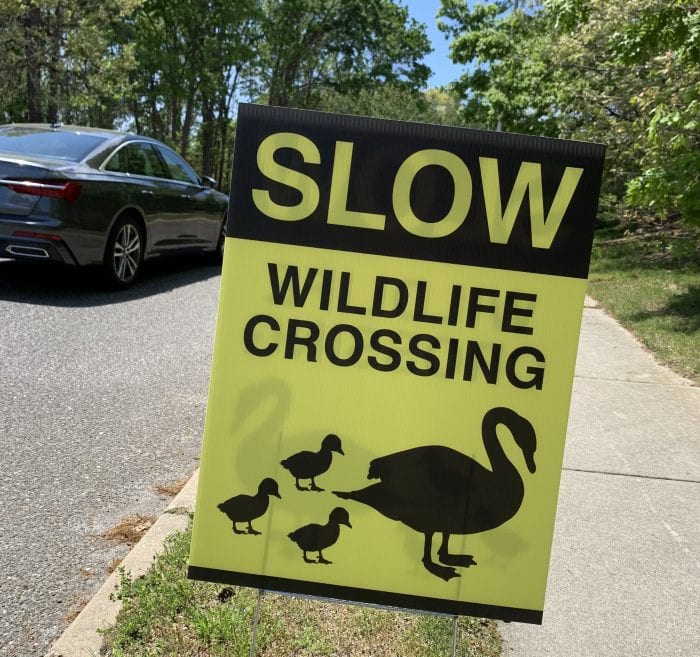Stony Brook Medicine employees raise awareness about geese crossings

Traveling down Belle Mead Road in the Three Village area drivers will notice wildlife crossing signs sprinkled along the way from the nature preserve to Route 347.
Volunteers installed the signs with the hope that drivers would slow down, especially when seeing wildlife, including geese who at times walk across the road when they have no feathers to fly.
Two years ago, Anita Jo Lago, of Stony Brook, was on her way to work at Stony Brook Medicine and ready to pull into the Tech Park parking lot when she saw a bonded goose pair starting to cross the street. She decided to park her car first before helping the waterfowl cross the road by stopping traffic, something that she had done several times before by her office.
Unfortunately, in the short time it took her to park her car, she said, a vehicle coming down the road, traveling approximately 50 mph on the 30 mph road, killed the first crossing goose.
“He died in my arms at the curb while his mate watched and waited,” she said.
Her co-worker Marianne Bastian saw how upset her colleague was over the incident, and came up with the idea of installing signs along the road. She said she was inspired by a neighbor who was running for local office and asked if people would put signs on their lawns.
Bastian contacted the Town of Brookhaven about installing signs along the roadway, filled out online forms, talked to property owners for approval to place the signs and more.
Lago, who is the wildlife coordinator at Frank Melville Memorial Park, said she doesn’t usually talk about her wildlife efforts at the office.
“I deal with wildlife a lot but I don’t usually talk about it at work, but I told [Bastian] and a light went off with her,” Lago said.
While the town initially put signs up near the Laurel Ridge Setauket Woods Nature Preserve, the women felt more was needed. That’s when they went to their work colleague, Donna Monte, to help with designing signs. Bastian added that colleagues then joined in to help pay for the signs which can cost around $10 each to print.
Bastian said she never did anything like this before.
“I do get very upset when I see a dead animal on the road, it’s just something that … it just breaks my heart,” she said.
Due to their efforts, there are now 20 reminders along the road, and the women are starting their third year during a time when Canadian geese eggs are hatching and goslings are joining their parents. Lago said the goslings started hatching about two or three weeks ago and now are walking around. The geese molt right after the eggs hatch so they can’t fly either. She said there are other animals who have been injured or killed by drivers, and this is the season where you see increased cases.
“Everything is moving about,” she said.
The signs will stay up until the goslings develop feathers and are able to fly.
Lago said Bastian, who travels from Sayville to work, checks the signs on the southside of the road, and she checks from the northside. Even with working from home during the pandemic, Lago said she would go out at night or on the weekends to check the signs. Or if Bastian saw an injured goose, she would call Lago who would come and see what could be done or call someone to help.
Both said while placing the reminders, many pedestrians have thanked them, and some drivers have even shouted gratitude out their car windows as they pass by.
Lago said she hopes the town might consider speed bumps, flashing lights or more police officers in the future. With the road recently being repaved, she said speeding has increased.
“I think it’s the mentality of being in a rush and going, going, going,” she added.






